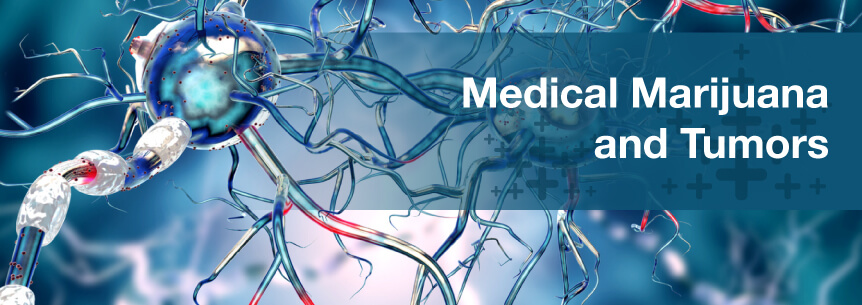
Many wonder if medical marijuana cures cancer, shrinks tumors or at least eases symptoms and side effects of cancer or its treatments like chemotherapy. The main reason patients turn to cannabis for their cancer is to treat their debilitating side effects. And, while there’s not yet an abundance of human trials to back up the claims about the plant for treating cancer, preclinical evidence continues to grow to suggest medical marijuana for tumors may be effective.
According to researchers, tetrahydrocannabinol (THC), the primary psychoactive ingredient in medical marijuana, may reduce the growth of tumors in patients with cancer.
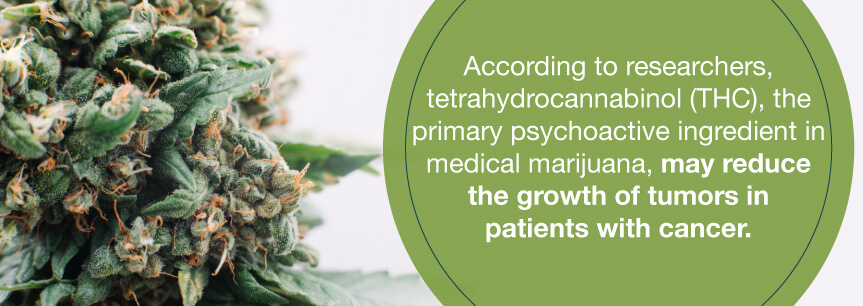
The research team found both cannabidiol (CBD) and THC dramatically reduced glioma tumors in their mice models. Glioma causes 80 percent of malignant brain tumors in humans. The study’s lead author, Dr. Wai Lu, reported to the Washington Post they found cannabinoids to be effective in a highly aggressive cancer in adults.
Since the 1970s, research studies have shown marijuana’s positive effect when used to treat cancerous tumors. And since then, case study after case study has confirmed these findings:
Since then, multiple studies continue to explore marijuana’s link to the prevention of tumor growth and the destruction of cancerous cells.
Medical cannabis for tumors may help you manage nausea, pain and other symptoms that go along with malignant tumor treatments, which is just one of the reasons cancer is a qualifying condition for legal marijuana in a growing number of states.
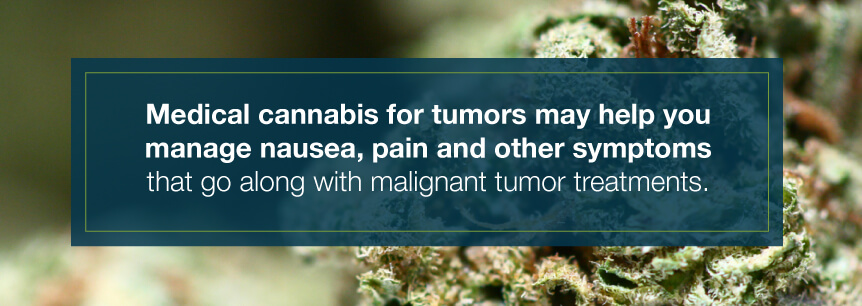
Marijuana helped slower neuropathic pain when other traditional treatments were unable to.
A common side effect of cancer treatments is weight loss due to loss of appetite and nausea. The THC in medical pot was effective at stimulating appetite in cancer-related cachexia patients, decreasing their risk of unsafe weight loss.
Additionally, those taking THC treatment had an increase in appetite and reported their food tasting better.
You may have heard “laughter is the best medicine.” Marijuana for tumors treatment offers euphoric, relaxing and mood-boosting characteristics which many patients found beneficial to their emotional and mental health.
Cannabis also helps patients fall asleep quicker and stay sleeping longer. These characteristics in medical weed may dramatically improve the quality of life in cancer patients and those with other severe health disorders.
Unfortunately, for those patients who like to smoke the herb, it’s probably not the best method to use for cancer. But, you can still get the benefits of marijuana and tumors treatment when using it in other delivery methods. Below are some methods of using your medical cannabis treatment.
No matter what method you choose, below are some of the best cannabis strains for tumors.
Cannabis strains for cancer pain:
Cannabis strains for nausea and vomiting:
Cannabis strains for appetite loss:
Cannabis strains for depression:
Cannabis strains for fatigue:
Many medical cannabis patients like to use high doses of full-extract cannabis oil in hopes of reducing tumors and ridding themselves of cancer. Here are some cannabis strains worth considering for your cannabis oil:
Now that you’ve learned some valuable information on cannabis and tumors treatment, it’s time to decide if it’s right for you. Search for a medical cannabis doctor to receive your marijuana card, then find a dispensary to start this treatment for cancer. Once you book your appointment with a medical marijuana doctor, be sure to use our handy marijuana recommendation appointment checklist.
Find A Doctor Find A Dispensary
Tumors are abnormal growths of cells having no real purpose. Benign tumors aren’t cancerous — malignant tumors are. Benign tumors don’t spread to other areas and parts of your body and invade nearby tissue as cancer does. For the most part, the prognosis of a benign tumor is good, but it can still be dangerous if it’s pressing up on essential structures like nerves or blood vessels. Therefore, some tumors require treatment, while others don’t.
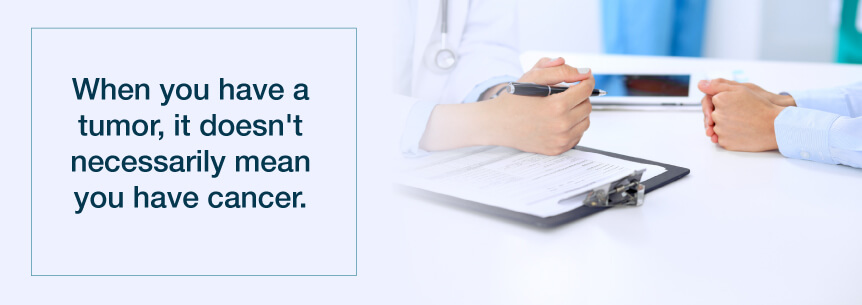
People often use the terms cancer and tumor interchangeably, and this can be misleading. When you have a tumor, it doesn’t necessarily mean you have cancer. A tumor is a mass or a collection of fluid. Cancer is a life-threatening type of tumor. It’s a good idea to know the difference between the two when you’re discussing a potential cancer diagnosis with your doctor.
Various types of tumors exist, all with different names. Their names typically are based on their shape, the tissue they are in and the cell origin. Doctors divide tumors into three main groups.
Throughout history, both humans and animals have had cancer. Therefore, it’s not surprising people have been writing about cancer from the beginning of history. Scientists found earlier evidence of cancer in ancient Egyptian human mummies, fossilized bone tumors and ancient manuscripts. They found growths in mummies indicating bone cancer, as well as bony skull destruction common with neck and head cancer.
Some suggest Hippocrates gave cancer its name because a tumor’s hardness could compare to a crab’s outer shell. Others thought he came up with the name because malignant tumor pain could have reminded him of a crab’s painful pinch.

Not all tumors have symptoms, regardless of if they’re benign, premalignant or cancerous. But various symptoms may occur to affect the function of your senses or important organs, depending on the location of your tumor.
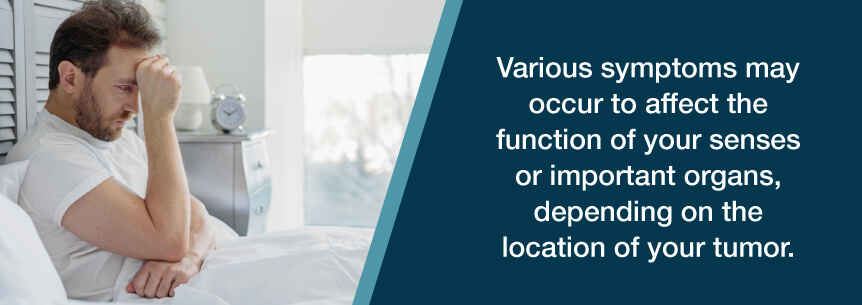
For instance, you could experience vision trouble, headaches and fuzzy memory with a benign brain tumor. If you have a tumor near some soft tissue like your abdomen or close to your skin, you may feel the tumor by touch.
Depending on where your benign tumor resides, possible symptoms you may experience include:
Your benign tumor may be big enough for you or your doctor to detect, especially if it’s close to your skin. However, most of these tumors aren’t big enough to cause pain or discomfort.
You may detect a malignant tumor in several ways.
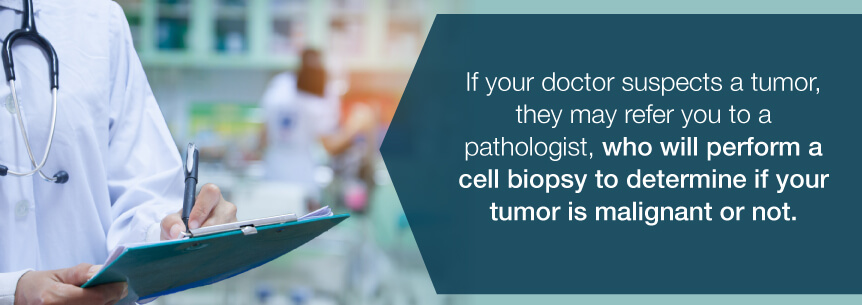
If your doctor suspects a tumor, they may refer you to a pathologist, who will perform a cell biopsy to determine if your tumor is malignant or not.
Tumors may cause systemic and other complications due to releasing specific substances. Doctors call these symptoms paraneoplastic syndromes, and they affect the disease’s course. Your doctor can diagnose many of the common symptoms, such as:
Your doctor will focus on the occurrence of syndromes, the pathogenesis, the relationship between certain types of tumor and potential forms of therapy.
Evidence supports the existence of post-traumatic stress disorder (PTSD) in both cancer patients and cancer survivors. Cancer causes traumatic experiences and has a high risk of being fatal, which can lead to PTSD.
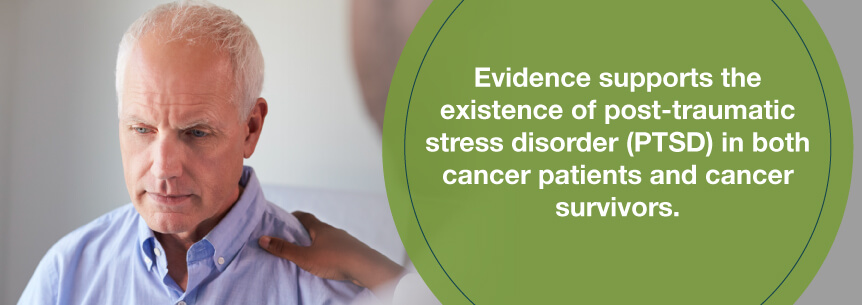
Cancer patients often receive a comorbid mental health condition diagnosis along with their cancer, like depression, anxiety and various other coping and stress adjustment conditions. Treatments for cancer may also cause anxiety and depression. Chemotherapy can cause a side effect called chemo brain, which can cause depression, mental fog, fatigue and other types of cognitive impairments.
Estimates published by the National Institutes of Health and reported by the American Cancer Society show:
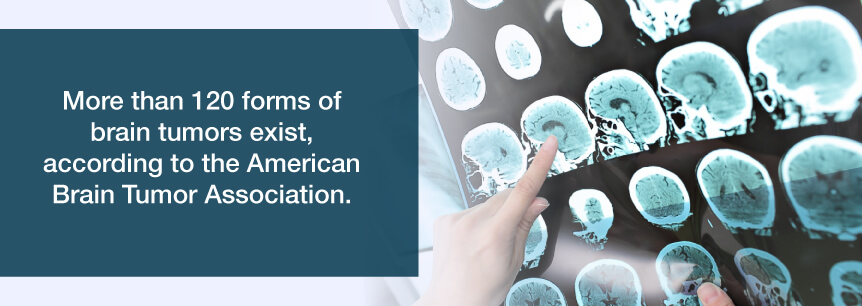
Your doctor will determine the proper course of treatment for you based on your tumor’s location, size and stage, as well as your overall health.
Benign tumors don’t always require treatment. If you have a small symptomless tumor, your physician may just watch it for a while before taking any action. They do this sometimes when treatment could put you more at risk than just leaving the tumor alone. Some tumors don’t ever require medical intervention.
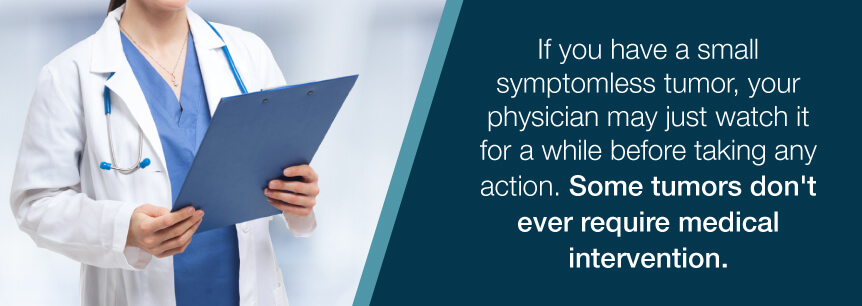
If your physician decides you need treatment, the type you receive depends on where the tumor resides. For instance, if the tumor is on your neck or face, they may remove it for cosmetic reasons. If your tumor is affecting your nerves, organs or blood vessels, your doctor will likely remove it with surgery to avoid further complications.
The surgeon uses endoscopic techniques during tumor surgery. With these, the instruments the surgeon uses are inside tube-like devices. The surgeon makes smaller surgical incisions with this technique, or none at all. It takes less time to heal and recover using endoscopic instruments, too. If your surgeon can’t access your tumor safely, they’ll likely prescribe radiation therapy to keep the tumor from getting bigger or reduce its size.
Common types of treatment for malignant tumors include the following.
The surgeon may give you chemo before surgery to shrink your tumor and lower the risk of the cancer spreading. They may also provide you with chemo after surgery to kill any remaining cancer cells and prevent or delay cancer from coming back.
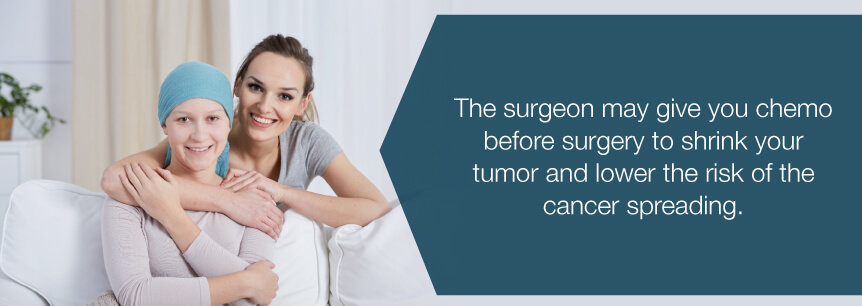
If your surgeon can’t remove your tumor with surgery, they may prescribe you chemotherapy as your primary treatment, sometimes combined with radiation therapy. The chemo might slow the tumor’s growth or shrink it down in size, but it’s not likely it will eliminate the tumor. Side effects of chemo may include:
Your doctor may use radiation therapy to treat your malignant tumor in a couple of ways:
Side effects of radiation therapy may include:
Hormone therapy is a type of systemic treatment doctors use to block, add or remove hormones from your body to stop or slow cancer cell growth. It typically involves medicine to keep your cancer cells from obtaining the hormones they require to grow. Your physician might remove the gland that produces hormones through surgery. They may also combine other cancer treatments with hormone therapy, like radiation therapy or chemotherapy.
Different types of hormone therapies may cause certain side effects for certain cancers. For instance, if you have breast cancer, you may experience vaginal discharge, irritation and dryness, hot flashes, mood changes or decreased sex drive. If you have prostate cancer, you may experience a reduced ability to orgasm or achieve an erection. You may experience a higher risk of osteoporosis and muscle and joint pain with aromatase inhibitors.
Cancer surgery provides you with the best chance of a cure for many tumors, particularly if it hasn’t spread. In cases where your surgeon can’t remove the entire tumor, such as if it would cause severe harm to an organ, they may get rid of as much of the tumor as possible to make radiation or chemotherapy more effective.
Your surgeon may perform surgery to relieve your symptoms and improve your quality of life, instead of trying to cure you of cancer. For instance, if the tumor is causing you a great deal of pain because it’s pressing on a bone or nerve or if it’s blocking your intestine, the doctor may perform surgery.
Typically, most cancer surgeries carry a risk of:
Your doctor may offer you any of these treatments by themselves, or a combination of them. In some cases, surgery is your best option for tumor removal and to prevent a recurrence, depending on the location of your tumor. Your doctor may recommend you try alternative therapies, along with treatment such as massage, natural remedies and dietary changes.